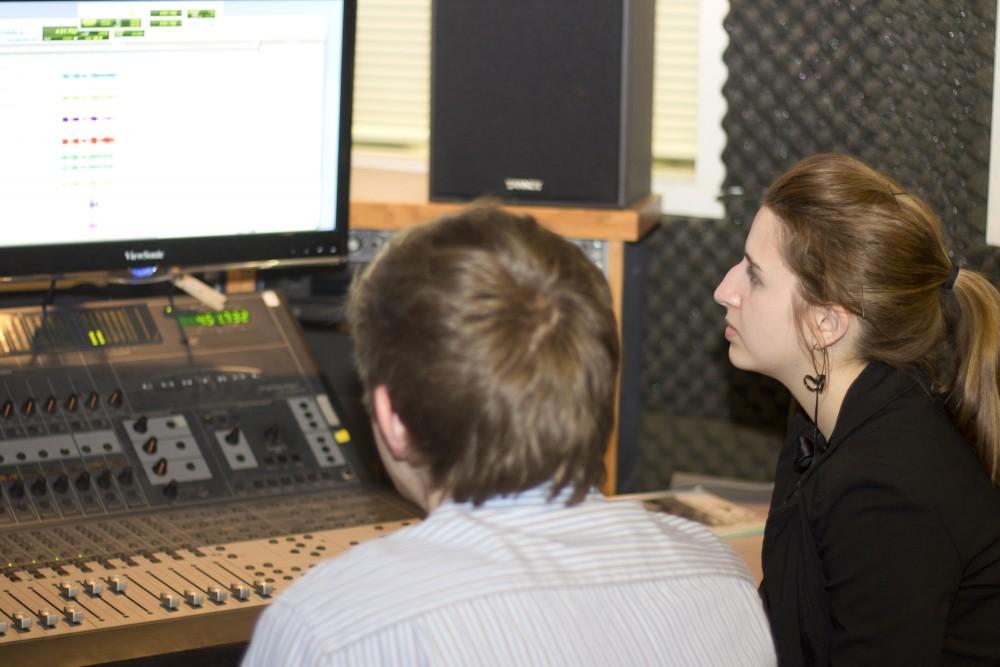Jazz musicians record demos with help from audio production students

GVL / Amanda Greenwood Students Ryan Rakowski and Noel Stojkov learn about recording in Grand Valley’s School of Communication’s sound studio
Feb 14, 2013
While developing the jazz combo program at Grand Valley State University, Mike Drost, associate professor of jazz guitar, set out to make sure his students had the same opportunities he had as an undergrad at Western Michigan University.
Now, student musicians have the opportunity to experience a professional recording session, ending with a product that is free and usable in their professional careers.
“When I was doing my undergrad, I spent days in the recording studio,” Drost said. “We learned the technology, how to record tunes and make them sound good.”
When Drost realized recording wasn’t happening at GVSU, last summer he decided to seek out Joseph McCarger, a School of Communications affiliate professor, for help.
McCargar had previously attempted to get musicians into the studio so his Audio Production I class had “guinea pigs” to work with. He was looking for a more systematic collaboration between the School of Communications and the music department.
“While most of my current students will not ever record music for a living, it is very challenging,” McCargar said. “The workflow of a music recording session is similar to many recording environments, from production field recording in film and video, and broadcasting to film post-production. In addition, recording and critiquing music requires listening skills that serve students in all the creative audio-visual disciplines.”
The collaboration recording sessions are now taking place during class time in the studio inside the Kirkhof Center. Their first session was Jan. 26, and the group recording was small, consisting of students Bill Scanlon on saxophone, Steve Rothstein on guitar and Wade Selkirk on drum set. They were without a bassist, so Drost ended up playing with them.
The group chose to record three jazz standards they were already familiar with, “Autumn Leaves”, “Blue Bossa” and “Sonny Moon For Two.”
“(Drost) emailed us about two weeks before so that we knew we had the opportunity,” Rothstein said. “I practiced all the tunes. I knew them before going in.”
McCargar’s students ran the session, a lengthy process that requires a lot of detailed knowledge about the inner workings of a recording studio.
“The greatest benefit to the students is their exposure to…an appreciation of how complex and precise the process of making art can be,” McCargar said.
It fell on his students to know how many players there would be, how to physically arrange them and to understand the technology used during the recording process.
Microphones were placed on the instruments and players were fitted with headphones so they could monitor their performance. The players underwent a sound check, testing the recording levels of the instruments to make sure everything was working properly. They rehearsed and finally recorded a few takes until the players were satisfied with the end result.
While Scanlon plays in the group, he also is enrolled in McCargar’s class.
“While they were recording the drums and bass, I got a chance to see how they were communicating with the musicians,” Scanlon said. “Down the road, when I want to produce my own music, as well as other people’s music, I know what to do.”
Although the first session was a live recording of the group, the second session was a multi-track recording. Each musician played his part alone to ensure a better isolation between instruments.
“Students all have documentation of what they sound like,” Drost said. “They can use the recordings for demos, self-promotion and to analyze their playing.”
And after the session, students received the files of their playing in an email.
“Listening to yourself after the session is over at such a professional quality is kind of a mind blowing experience,” Rothstein said. “You record for yourself, and it’s a way to distribute your music to market yourself.”
The sessions are free to students, and are not limited to jazz musicians, but anyone who has something recordable to offer and is interested in recording.
“It’s making something out of nothing, and is a documentation of what you’re doing in that moment,” Drost said.






















